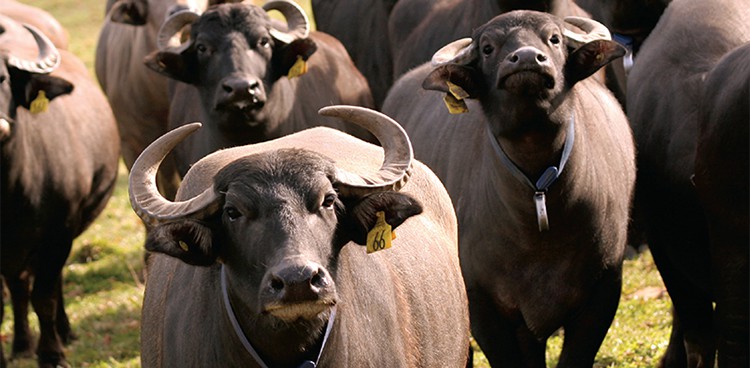
Origin
A truly ancient creature, the water buffalo has been a dutiful servant of man for over 5,000 years. Not to be confused with the African Cape buffalo, North American Bison, or the endangered—and dangerous—wild Asian water buffalo from which it has descended, the domesticated water buffalo is a docile creature ideally suited to life as a dairy, draft, and companion animal. Originating in Asia, the breed was introduced in parts of Africa and the Near East around AD 600 and brought by returning Crusaders to Europe—and famously, Italy—during the Middle Ages.
History
Today, the water buffalo boasts a world population of around 168 million and produces between 5 and 15 percent of the world’s milk as well as 20 to 30 percent of the farm power in Southeast Asia. In addition to milk, this placid creature provides families all around the world—from the lush tropics to the harsh Nepalese steppe—with meat, leather, and draft power. However, it’s only recently that the water buffalo has been farmed as livestock in western Europe and the United States.
Appearance
Domestication changed the once formidable wild water buffalo (which weighed as much as 2,650 pounds) into a smaller (650- to 1,300-pound), slower, and considerably more tractable beast. These animals are intelligent and polite, typically lining up in orderly queues for their showers and electronic milking. They vary in color from a light cream to a dark mocha brown. Unlike the modern dairy cow, water buffalo can thrive on relatively low-quality forage. The breed is also known for forming lasting bonds with their human owners, and in many parts of the world they are herded and tended by the youngest members of the family. There are even stories of water buffalo protecting their masters by fending off attacks by crocodiles and tigers.
Milk & Cheeses
Water buffalo milk is creamy and smooth, with a beautiful snow-white color. A composition analysis shows that buffalo milk is a rich source of iron, phosphorus, and vitamin A and that it contains 58 percent more calcium, 40 percent more protein, and 43 percent less cholesterol than cow’s milk. It’s also easier to digest for people with a cow’s milk allergy and is milder tasting than sheep and goat milk. However, with 18 percent total milk solids and seven to nine percent butterfat, it’s also extremely rich. Perhaps the most famous water buffalo product is Italy’s mozzarella di bufala, but the animal’s milk also makes fine butter, ice cream, and yogurt. And thanks to a high percentage of milk solids, buffalo milk offers significant advantages during processing—yogurts reach a natural thick set without the addition of milk proteins or gelling agents.
Feature Photo Credit: Vermont Water Buffalo, Inc.





2 thoughts on “Farm Animal: Water Buffalo”